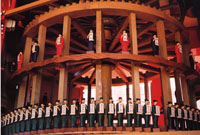The most typical
automatic musical instrument of the Middle Ages was a clock with bells
attached. There was a great variety, from simple devices giving time
signals to complex mechanisms playing entire pieces of music, and it is
almost impossible to decide at which point a “clock” became an
“automatic musical instrument.” Astronomical clocks proving the highest
level of scientific and technological research of that age show the
orbit not only of the sun but also of the moon, the planets, and the
fixed stars. Clocks thus showed the harmonic movements of the universe,
and it was believed that successful politics could happen only in
unison with these movements. The possession of an astronomical clock
thus meant that one knew the movements of the heavens and therefore had
power on earth. Music was also believed to be a reflection of the
universal order. It is thus only natural that beautiful melodies were
used to announce the hours. This concept is found not only in Western
culture but also in the East. The photo on the right side shows a Chinese
observatory built in the 11th century, as it has been reconstructed
in Shimosuwa Town in Nagano Prefecture. It contains a water-driven
astronomical clock, proving that science and technology were very
advanced in China at that time compared to Europe. But if we read what Cicero
writes about Archimedes’ planetarium, it seems possible that
similar complex astronomical models already existed in ancient Europe.
The Chinese water-clock does not play melodies, but various musical
instruments are used for the announcement of time.
H. G.
H. G.

